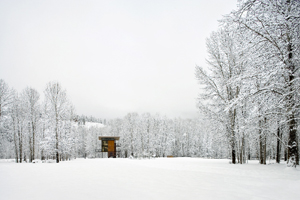JM: You’re often described as a Pacific Northwest firm, but you’re doing stuff around the country, right?
TK: There are four owners in the firm and all of us are doing more and more work around North America, both Canada and the United States. In fact, I had some people in the office take a map and note with red dots some of the projects I’m working on right now. It’s almost like a spiral that’s coming out of the center of Seattle and it’s reaching all the way to Alaska, reaching down to Texas, over to Spain, possibly something in Pakistan, and my partner is doing some work in Hong Kong. What we’re doing here in the Northwest is having some sort of resonance with people around the world and I hope it continues because it really is frankly fascinating to be working with some shadings of different cultures and different landscapes. The idiosyncrasies between the places are really what fascinate me—cultures and the landscapes are probably the part of my work that fascinate me the most.

![]()
What are some of the specific differences and similarities that Kundig sees when it comes to housing in different cultures? Click here for his one-minute answer.
JM: You mentioned something in Pakistan?
TK: Well, it’s only a potential project at this point and it may never happen, but what it’s interesting is that someone in Pakistan might even be remotely interested in somebody’s work in Seattle. With the World Wide Web, obviously, it’s just becoming just a much, much smaller world and there are connections between these different places. Another perfect example is the project I’m doing in Spain. I was actually recommended to the client who is from Norway and lives in Paris—but I was recommended to the client by somebody who lives in South Africa. Before I was contacted I didn’t know any of these people. So, I’m working on a project in Spain for a Norwegian owner that was recommended to me by somebody in South Africa.
JM: That’s a really interesting mix of cultures right there. What are some of the idiosyncrasies and some of the similarities you’ve noticed among them?
TK: I think there are more similarities, frankly, than there are dissimilarities between the cultures. There certainly exist dissimilarities between cultures, even in the United States. I’m working in the South and there are shadings, there are differences; and on the East Coast there are differences to the West Coast culture. But, if I’m working in Spain with a Norwegian who is building a house and a photo studio there, I find that the cross cultural differences are, at best, gray tones and not dramatic. Now, that might be different if in fact I work in eastern cultures and places like Pakistan, but I don’t know at this point.
JM: So we’ve been talking about houses shrinking and yet satisfying elemental human needs; we’ve talked about the shrinking global village; are there any other trends along these lines that you see?
TK: I think we’re living in just a terrifically wonderful period of architecture. I don’t think we’re leading the revolution, I think architects reflect a revolution more than anything, but there are some rumblings afoot that are changing things. They’re good changes. So I couldn’t be more excited about a lot of the things that are happening in my profession and in other professions. What I’m also sensing, and I hope this is true more in the future—and the Academy of Arts and Letters Award is one of these indicators—is that there is a little more understanding of the inner relationships between the different arts and creative fields. The most fascinating thing for me about the Academy event was the relationships between the writers and poets and musicians and architects and artists. We all naturally have more of a relationship between each other. I learn more from creative people in other disciplines than I do even from other architects because I think they have a way of looking at the world that is really important. I hope that in the future we see more and more interweaving between these different disciplines.
JM: Is it collaboration, or something more than collaboration?
TK: I don’t know if it’s collaboration. I think it’s trying more to understand the different ways of looking at our world. Ultimately, again, I think architects sort of reflect what’s happening in the world. And I think many of these people are doing the same thing. They have a different perspective on it, a different way of understanding. They touch on different parts of our soul. Of course, architecture is about touching a lot of different parts of our soul: visual, aural, even smelling. It’s sort of a like a total emersion in the arts. Well, these folks: some of them are more visual, some of them are more literal, some are more spatial, some are more musical. They are sources of getting in touch with those really important sensitivities that architects need to make special places. I think they’re just terrific people to get to know.

Post a comment to this article
Report Abusive Comment